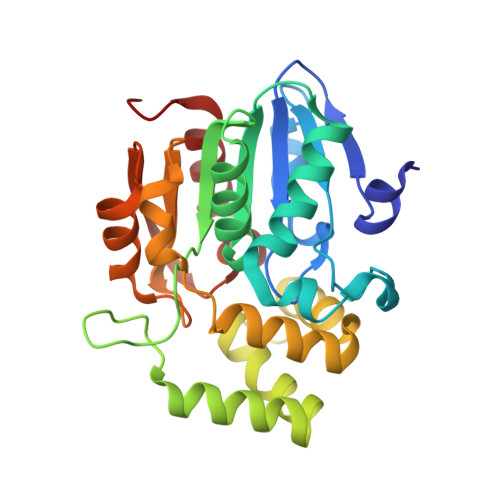A Divergent Clade KAI2 Protein in the Root Parasitic Plant Orobanche minor Is a Highly Sensitive Strigolactone Receptor and Is Involved in the Perception of Sesquiterpene Lactones.
Takei, S., Uchiyama, Y., Burger, M., Suzuki, T., Okabe, S., Chory, J., Seto, Y.(2023) Plant Cell Physiol 64: 996-1007
- PubMed: 37061839
- DOI: https://doi.org/10.1093/pcp/pcad026
- Primary Citation of Related Structures:
7UOC - PubMed Abstract:
Strigolactones (SLs) were initially discovered as germination inducers for root parasitic plants. In 2015, three groups independently reported the characterization of the SL receptor in the root parasitic plant Striga hermonthica, which causes significant damage to crop production, particularly in sub-Saharan Africa. The characterized receptors belong to HYPOSENSITIVE TO LIGHT/KARRIKIN INSENSITIVE2 (HTL/KAI2), which is a member of the α/β-hydrolase protein superfamily. In non-parasitic plants, HTL/KAI2 perceives the smoke-derived germination inducer karrikin and a yet-unidentified endogenous ligand. However, root parasitic plants evolved a specific clade of HTL/KAI2 that has diverged from the KAI2 clade of non-parasitic plants. The S. hermonthica SL receptors are included in this specific clade, which is called KAI2 divergent (KAI2d). Orobanche minor is an obligate root holoparasitic plant that grows completely dependent on the host for water and nutrients because of a lack of photosynthetic ability. Previous phylogenetic analysis of KAI2 proteins in O. minor has demonstrated the presence of at least five KAI2d clade genes. Here, we report that KAI2d3 and KAI2d4 in O. minor have the ability to act as the SL receptors. They directly interact with SLs in vitro, and when expressed in Arabidopsis, they rescue thermo-inhibited germination in response to the synthetic SL analog GR24. In particular, KAI2d3 showed high sensitivity to GR24 when expressed in Arabidopsis, suggesting that this receptor enables highly sensitive SL recognition in O. minor. Furthermore, we provide evidence that these KAI2d receptors are involved in the perception of sesquiterpene lactones, non-strigolactone-type germination inducers.
- Laboratory of Plant Chemical Regulation, School of Agriculture, Meiji University, 1-1-1, Higashi-mita, Tama-ku, Kawasaki 214-8571 Japan.
Organizational Affiliation:

















